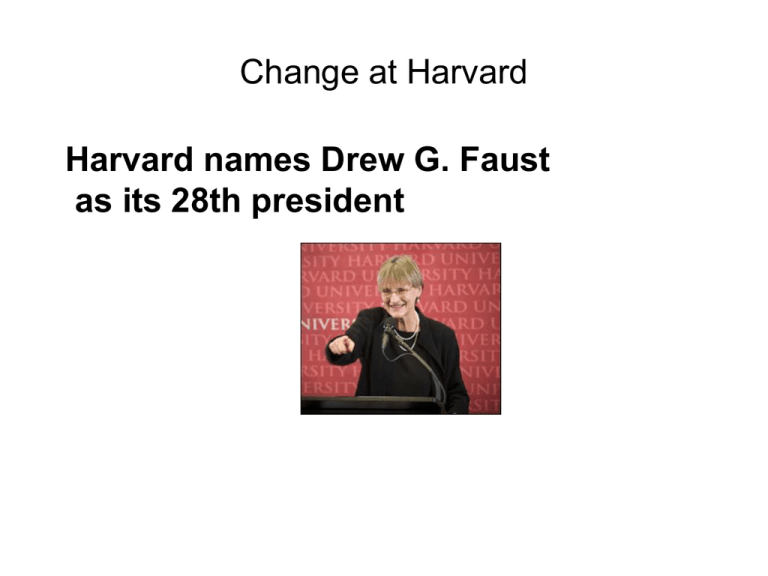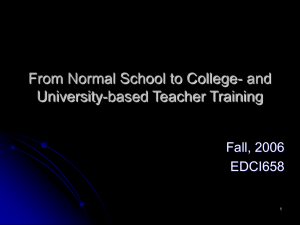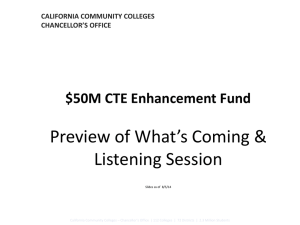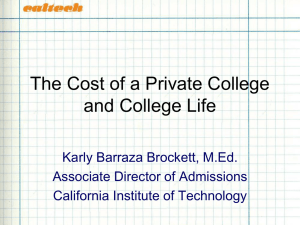Land Grant Colleges
advertisement

Change at Harvard Harvard names Drew G. Faust as its 28th president Transformational Era 1870 -1944 Morrill Land Grant to Serviceman’s Readjustment Act 1850 120 colleges 47 law schools 42 theological seminaries No ag, manufacturing, practical arts 1856 Congressman Justin Morrill, VT Purpose: To promote the liberal and practical education of the industrial classes in the several pursuits and professions of life. …to teach such branches of learning as are related to agriculture and the mechanical arts… Land Grant Colleges Federal government involvement on HE that changed the direction of HE in the United States Land Grant Colleges • Morrill Act – Wayland @ Brown 1850: “US has 120 colleges, 47 law schools, 42 theological seminars and not a single institution designed to furnish the agriculturalist, the manufacturer, the mechanic, or the merchant w/the education that will prepare him for the profession to which is life to be devoted.” – 1860 Pennsylvania had a farmer’s high school – 1857 Michigan State had a college of agriculture – Proposed by Justin Morrill of Vermont in 1856 and 1859; vetoed by Buchanan-states rights – Purpose: “Learning objective shall be, without excluding other scientific or classical studies, to teach such branches of learning as are related to agriculture and the mechanical arts.” – Policy Issues: land grants to support education or build economy, federal gov’t had land and debts • Options: Sell land to raise $/donate land to increase prosperity (Homestead Act/RR) increase agricultural production to increase prosperity Land Grant Colleges • Morrill Act cont. – 1862: Public lands given to each state: 30,000 acres for each senator/rep • : Public land for each state; approx 17 million acres; average return $1.65; 10% land purchase; invest remainder…perpetual endowment – By 1961 69 institutions were being supported by these funds – Land grant college models: • Existing schools: :Michigan state, Penn State, Wisconsin • New Systems: Texas A&M, Oklahoma – Impact on private colleges • Ag. Education as tough sell: Philly newspaper “Instead of introducing the student of agriculture to a lab and chemical and philosophical apparatus, we would introduce him to a pair of heavy boots and corduroy pants and learn him how to load manure.” • States invest in public land grant colleges Land Grant Colleges • • • • • Morrill Act Continued 1863 US Commissioner of Education: These colleges are not to be agricultural only; the sons of our farmers are not less ambitious of distinction than others.” Migration off the farms/better life Body of knowledge Univ. of MO brochure on agriculture: He can work better and sleep better who has well kept lands and beautiful perspective How did the land grants make it? – Hatch Act 1887 brings science to farmers – 1890 land grant course offerings: animal husbandry, veterinary medicine, agronomy, plant pathology, agricultural botany, agricultural chemistry, farm management. Where is the classical curriclum? Land Grant Colleges • Morrill Act 1890: 2 major components 1. Provided more funding for existing land grant institutions 2. Greater accountability – subjects to be taught were specified 3. Established Black Land-Grant Colleges • • “At a time when many schools barred their doors to Black Americans, these colleges offered the best, and often the only, opportunity for a higher education.” – George Bush, 1991 Challenges for Black institutions – 90% of African Americans lived in the South • 84% were farmers, overseers, sharecroppers, or employed in domestic jobs – Plessy v. Ferguson (1896): “Separate but equal” • Rise in Jim Crow laws – Funding disparities with their white counterpart institutions Opposition remains: traditional classical curriculum; denominational interests • SC legislator: “I have never seen a man who could write a nice essay or make a good agricultural speech who could make enough corn to feed himself and a bobtailed mule.” Land Grant Colleges • “…no money shall be paid out under this act to any State or Territory for the support and maintenance of a college where a distinction of race or color is made in the admission of student, but the establishments and maintenance of such colleges separately for white and colored students shall be held to be a compliance with the provisions of this act if the funds received in such State or Territory by equitably divided as hereinafter set forth” • Consequences – Poorer facilities and budgets – Lacked adequate libraries and scientific and research equipment and capabilities Land Grant Colleges • • Institutional Leadership Charles Eliot (Harvard) – Graduates 1853, tutor until 1863, math prof. MIT 1869 – President, Harvard 1869-1909 • Reforms – 1872 abolish required courses for seniors – 1897 rhetoric only required freshman course – 3 principles: freedom of choice in studies, all subjects accorded equal value/standing, individual responsible for conduct – Why do reforms work—take hold? • Eliot @ Harvard appoints Ephraim Gurney: history faculty member, dean of the college; responsible for: instruction, registration, student welfare – 1890-1891 divide Dean position: Charles Dunbar-dean of the faculty, LeBaron Briggs-dean of the college w/responsibility for students—Dean of men – Marion Talbot-Dean of women @ Chicago Land Grant Colleges • • Eliot Cont. 4 models – – – – • • Most of curriculum elective Half elective half prescribed Major/minor system Hopkins group system-Jefferson’s idea @ VA Expansion of the curriculum, introduces specialization and academic departments. Competition w/in institutions. 1903 study leads to 1910 reforms – Concentrations (major/minor) and distributions (groups) • Results of elective curriculum: Expansion of course offerings, including vocational, rise of the sciences, equal footing for all offerings, struggle b/w sciences, need libraries to support courses, need labs to support pure and applied science, graduate work in academic specialty in Germany & Scotland/expectations of faculty, student expectations for practical education Wisconsin Idea • People’s university in service to the people of state • Hatch Act extension centers in every county; bring the expertise of the lab to the country side • Faculty as advisors to government officials Draft legislation Apply social sciences knowledge to state issues State Street in Madison: campus on one end facing state capital on the other end Land Grant Colleges • • David Starr Jordan IU/Stanford: “BS degree has come to mean bachelor of surfaces b/c the expansion of the curriculum meant that students only touched the surface.” End of intellectual unity/driven by social forces… Land Grant Colleges were the pot of gold for many students






